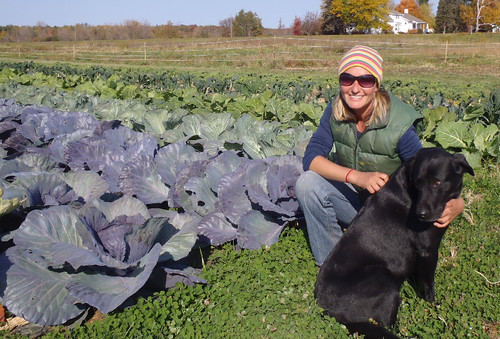
When studying abroad in France and Spain, Sarah Woutat developed a love for organic farming after working on farms in both countries. The love was so strong, she retired from her New York City life working for an environmental publishing business and returned to farming.
After an apprenticeship at Fort Hill Farm in Connecticut, she returned home to her native state of Minnesota to run Uproot Farm.
Uproot Farm is a small vegetable farm just one hour north of the Twin Cities. This farm turns a profit on just five acres. The farm sells community supported agriculture, or CSA, shares to people in nearby Cambridge, Minn. as well as Minneapolis. When a person buys into a CSA, they’re guaranteed a certain amount of the farm’s harvest and the farm receives financial support up front.
Not long after she founded Uproot Farm, Woutat visited her local USDA service center. There, she met with Josh Bork, a district conservationist with USDA’s Natural Resources Conservation Service.
Bork worked with Woutat on a conservation plan, which is a roadmap of her objectives for her farm that integrates conservation practices that benefit the farm and the nearby environment. Through this technical assistance, she wanted to address natural resources concerns such as plant condition, soil condition because of compaction and organic matter depletion.
To address these resource concerns, Woutat decided to apply for the Environmental Quality Incentives Program, a Farm Bill program that offers financial assistance to farmers and ranchers, including farmers like her who are newer farmers and manage small- and mid-size farms.
As a beginning farmer, EQIP made sense, she said. The financial assistance enabled her to install a high tunnel and field borders.
While high tunnels may look like greenhouses, growers manage them quite differently. In high tunnels, plants are grown directly in the ground. High tunnels don’t use heaters and lights. Opening and closing the high tunnel regulates the sun’s heat. Right after it was built in September, she planted a crop of spinach.
Her first crop yielded 126 pounds. The following spring she planted and harvested several vegetables, including tomatoes, carrots, beets, spinach, salad mix and radishes.
“She was very happy with the spinach crop that she harvested in the fall of 2011, just two months after the seasonal high tunnel was set up,” Bork said.
Field borders are strips of plants, typically native grasses that help catch sediment and nutrients, keeping them from entering waterways. The Isanti Soil and Water Conservation District and NRCS helped her implement these strips of plants to catch sediment and nutrients.
“Working with a beginning young farmer such as Sarah helped me learn more about the CSA operations and how it could fit into NRCS technical assistance and programs,” Bork said.
To get started with NRCS, visit your local USDA Service Center or www.nrcs.usda.gov/GetStarted.

